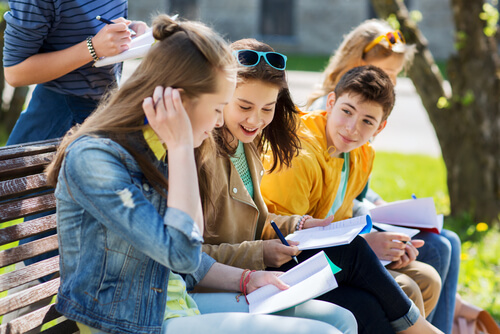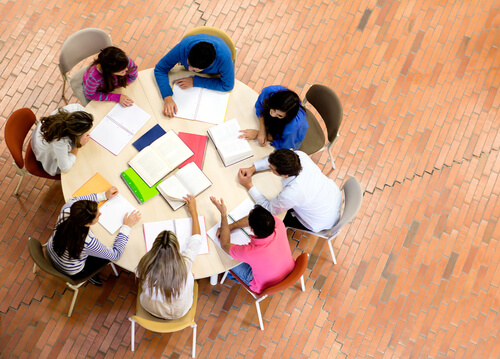7 Characteristic Habits of Highly Creative Schools

In today’s article we’ll be discussing some of the common characteristics and habits that highly creative schools have.
Many educational trends that are going on right now are against the contemporary educational system. The idea of having students sit down for hours and simply receive information seems outdated and ineffective.
The latest educational theories stress the importance of creative, critical, collaborative, and motivational learning. Current education experts say that educational priorities must fit the needs that future society will impose on students.
Priorities have changed drastically in the last 10 years, just as the rest of the world has. Sooner or later, the capacities of creation, critical analysis, and entrepreneurship will have the same importance as technical knowledge, or even more.
7 characteristic habits of highly creative schools
Several educational institutions have set out to change the paradigm. They’re implementing simple actions that are slowly but surely resulting in important changes for students.
These are the most characteristic habits of highly creative schools:
1. Celebrating and rewarding collective achievements
The world is always in need of teamwork. In fact, it’s been proven that students learn more when working in groups than working individually.
Consequently, encouraging and rewarding the good results they achieve when working in groups is an excellent step.
2. Not focusing on specializations
Instead of dividing learning into rigid areas, what these schools do is combine different fields. This is called an interdisciplinary approach.
A great strategy they use is asking students to do projects that mix several subjects instead of focusing on only one. Teamwork is one of the main habits that drive highly creative schools.

3. Encouraging taking risks and giving value to failure
Repressing children or teenagers for not obtaining expected results isn’t beneficial at all. On the contrary, failure is very important because it’s what helps us learn and do better next time.
This isn’t something easy to do since many parents are afraid of jeopardizing their children’s self-esteem, which leads to overprotective parents who don’t want to tell their children when they’ve made mistakes.
In fact, many parents don’t even let their children make mistakes – they’re so afraid of it, they end up helping their children way too much and doing all their work for them.
These schools give value to students’ effort. They take trial and error into consideration.
That’s why instead of being against making mistakes, they encourage students to be creative and give things a try. After all, if something doesn’t go the way they planned, they can learn from it and try again.
4. Students aren’t passive consumers
In fact, highly creative schools encourage the opposite of this. They don’t want students to be bombarded with information, numbers, and dates. They know that’s not the best way to learn and that they’re just going to end up overwhelmed and frustrated.
Instead of transmitting information in a vertical way, modern schools try to build knowledge through researching. They prefer for activities to be collective and proactive. That’s why their usual terms are LBD (Learn by doing) and PBL (Project-based learning).
5. They have intrinsic incentives for learning
Traditional education has a very “primitive” method to reward students’ good results. What we mean by this is that it’s always been the same.
They’ve never really changed the way they motivate students to keep getting better. These methods are grades, awards, and scholarships.
On the contrary, this new institutional model favors the education that it gives through the students’ motivation.
This means that, instead of rewarding students to motivate them, the motivation is intrinsic in them – they genuinely want to continue learning and discover how far they can go.
6. Stimulating creative disciplines
Subjects such as art, music, design, literature, and drama are getting more and more recognition worldwide, and are being included in renowned institutions all around the globe.
In fact, they used to be pretty popular and basic within schools back in the day, but they lost ground against subjects like math, philosophy, and science.
There are many benefits of activities that require putting visual thinking to work. For example, they enhance attention, concentration, retention of information, and greatly improve people’s capacity for expression.
The habits of highly creative schools encourage teamwork and proactive learning.

7. Providing an appropriate environment to stimulate imagination
No matter how good the teachers are or how much teamwork is promoted in the school, if students don’t feel comfortable in their educational environment, they’re not going to get the best results.
Instead of keeping students in closed classrooms with artificial lighting, these schools create open, ventilated, and cheerful environments for students to do their work in.
However, this isn’t an easy task. Something that’s both beneficial to the school and to the students is to involve them in the setting process. This is a great exercise for their imagination and creativity.
Additionally, they’ll be able to decorate and set the classroom the way they want, just as long as they do it within the parameters set by the school.
These are all characteristic habits of highly creative schools, which have definitely proven to have good results among students.
Without a doubt, these measures will continue to become popular in the educational world and, who knows, maybe this type of schooling will be the norm in the near future!
This text is provided for informational purposes only and does not replace consultation with a professional. If in doubt, consult your specialist.
